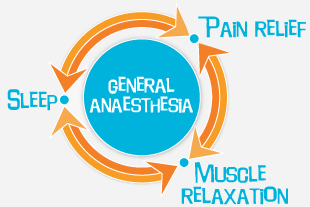 General anaesthesia refers to a induced state of sleep with an absence of pain and sensation throughout the body. There are 3 key components to general anaesthesia:
General anaesthesia refers to a induced state of sleep with an absence of pain and sensation throughout the body. There are 3 key components to general anaesthesia:
- Sleep
- Muscle relaxation
- Pain relief
Your anaesthetist will meet you and place a plastic cannula in your arm. Medicine will be given through this cannula which will put you to sleep. Anaesthetic gases will then be administered to maintain this state of sleep. Your anaesthetic doctor will be with you throughout the operation, carefully assessing and monitoring your heart rate, blood pressure and breathing. At the end of the operation you will be gently woken in comfortable and relaxed state.
Your highly trained anesthetist will be with you every step of the way. Modern general anaesthesia is very very safe, however all operations and all anesthetic procedures have some risk associated with them. These risks depend upon many factors, including the type of surgery and your medical condition.
Common side effects :
- Nausea or vomiting
- Headache
- Pain and/or bruising at injection sites
- Sore or dry throat, mouth or lips
- Dizziness
- Difficulty with passing urine.
- Damage to native or prosthetic teeth
Less common side effects:
- Muscle aches and pains
- General fatigue
- Mild allergic reaction such as rash or itch
- Temporary nerve damage
Uncommon side effects:
- Being awake under general anaesthetic
- Visual changes of impairment
- Heart attack
- Stroke
- Severe allergic reaction
- Pneumonia as a result of regurgitation of food, drink or stomach acid
- Permanent nerve damage
Your anaesthetist will discuss your individual risks with you. We encourage you to raise your specific questions and concerns with them prior to your procedure.
